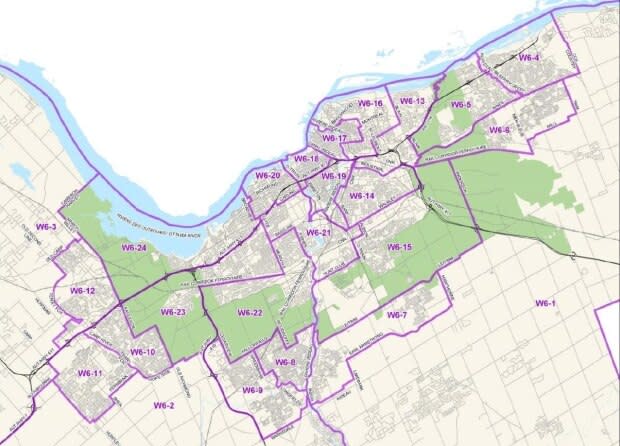Cumberland residents fear 'giant' rural ward when map is redrawn

Some residents of Ottawa's eastern-most ward say they're concerned their francophone and rural voices will be diluted if their ward is merged with neighbouring Osgoode when the city's electoral map is redrawn.
Candidates in the current Cumberland byelection confirm they're hearing from constituents about the city's ward boundary review, and its potential implications for the ward, while out knocking on doors.
Whoever wins the vote on Oct. 5 will likely be fighting for re-election to represent an area that looks very different in two years.
That's because all six boundary maps now on the table hive off the suburban Orléans portion of Cumberland ward so that it stands alone. Its rural swath would be merged with Osgoode ward to the southwest.
Not only would that reduce the number of rural representatives on council from four to three, but it would also leave one councillor to represent a "giant" or "mega" ward of more than 800 square kilometres, say those with deep ties to the existing community.
Linda Dunn pities the councillor who would have to represent a dozen rural villages and even more community associations, driving long distances between community events.
"Can you imagine the poor person who has to represent this? It defies logic," said Dunn, who was herself a councillor and deputy mayor in Cumberland Township prior to amalgamation.
Losing their voice
Francophones also worry what it will mean if rural Cumberland is absorbed by its predominantly English-speaking neighbour, which includes the villages of Greely, Metcalfe and Osgoode.
"We will lose part of our voice in the community and before the City of Ottawa," said Caroline Etter, president of the Sarsfield Community Association, who said bilingual services in the city are already inadequate.
"It doesn't make any sense," agreed Francis Drouin, MP for Glengarry–Prescott–Russell.
Drouin notes municipal government is supposed to be the level closest to the people, but he doesn't see how such a large ward can properly represent villages like Navan or Sarsfield, or their rural, francophone voices.
The consultants had noted in August that a new Osgoode-Cumberland ward wouldn't be much bigger than existing West Carleton-March at 765 square kilometres, or Rideau-Goulbourn at 728 square kilometres.

Pandemic brought change
Both Dunn and Etter are frustrated the city is looking at such sweeping changes during a pandemic, and when there's no sitting councillor to keep residents informed.
The city held consultations last winter, but suspended them as COVID-19 quickly shut down gatherings in March. Consultations held this month were done by video, which critics say doesn't suit rural residents with poor internet connections.
With nearly 52,000 residents, Cumberland's growing population is larger than other wards, and needs to be redistributed. Only one-quarter of its residents live in the rural areas, however, and consultants suggested that voice was being drowned out by the concerns of a booming suburb.
But Dunn counters that people in the rural east end shop and go to school in Orléans, and many haven't even been to the Osgoode area. She said it's wrong to premise the redistribution of wards based on "rural people do rural things and urban people do urban things."
Former Cumberland councillor Stephen Blais said it was a delicate balance to represent both suburban and rural interests for a decade but he doesn't think residents of Navan and Osgoode share a connection, either.
"There is already an imbalance between east and west in Ottawa and adding yet another elected voice to the west end will just diminish the capacity to have a voice in the east end," said Blais.


